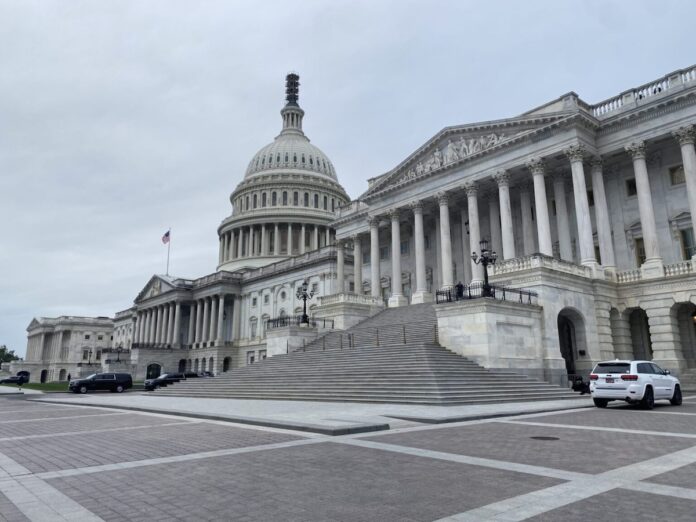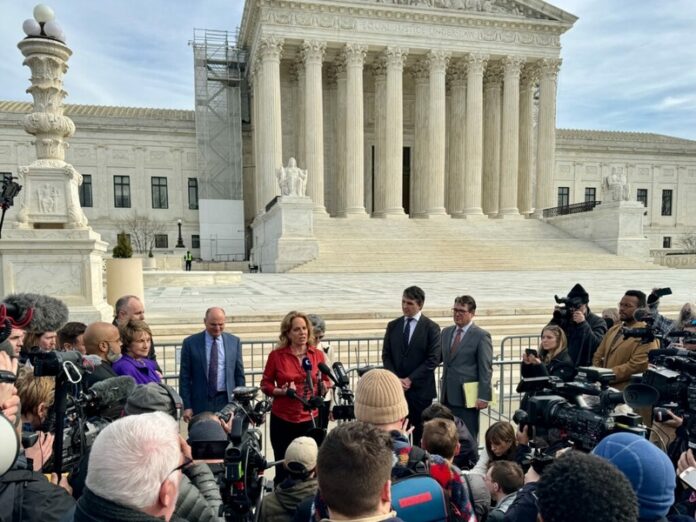WASHINGTON (States Newsroom) — Congress is on track to approve a staggering $468 billion in government spending this week, finishing part of the work it was supposed to complete by Oct. 1 — including a big boost intended to shore up the federal WIC nutrition program for women, infants and children.
Other agencies will see cuts, including the FBI and the National Park Service, as Democrats and Republicans haggled over winners and losers in the annual spending process. There are spending increases for items such as wildland fire management, first-time-ever federal oversight of cosmetics and emergency rental assistance for low-income families.
Surviving: Plenty of earmarks for lawmakers’ local projects, also referred to as congressionally directed spending or community project funding, which received $12.655 billion in spending for the 6,630 projects within the six spending bills combined into one package, according to two people familiar with the total.
For example, the bill that provides funds for the U.S. Department of Agriculture and the Food and Drug Administration includes everything from $3 million for the Integrative Precision Agriculture Laboratory at the University of Georgia Research Foundation Inc. to $800,000 for Livingston Parish Courthouse Renovations in Louisiana to $3.3 million for the Pinetop Wildland Fire Response Station in Arizona.
The U.S. House and Senate are expected to take broadly bipartisan votes to send the package known as a “minibus” to President Joe Biden ahead of a Friday midnight deadline.
However, agreement on six other consequential appropriations bills, which are due by March 22 and include health, defense and homeland security programs, remains elusive.
Dems tout WIC funding
The first batch of government funding bills brokered by the divided Congress includes the Agriculture-FDA, Commerce-Justice-Science, Energy-Water, Interior-Environment, Military Construction-VA and Transportation-HUD measures.
Senate Appropriations Chair Patty Murray, a Washington state Democrat, said in a statement released Sunday that she and other Democratic lawmakers “fought hard to protect investments that matter to working people everywhere and help keep our economy strong—rejecting devastating cuts to housing, nutrition assistance, and more.”
“Forcing states to pick and choose which moms and kids will be able to access essential WIC benefits was never an acceptable outcome to Democrats, and this bill ensures that won’t happen by fully funding WIC for millions of families nationwide,” Murray said, referring to the Special Supplemental Nutrition Program for Women, Infants and Children, known as WIC, which provides grants to states and had faced a shortfall.
Maine Republican Sen. Susan Collins, ranking member on the panel, said in a written statement the “bills will make a real difference in communities throughout the United States.”
“Members of the Appropriations Committee in both chambers have worked very hard to reach agreements on the bill text unveiled today,” Collins said. “I look forward to working with Chair Murray and our colleagues to bring this legislation to the Senate floor for a vote without any further delay.”
House Appropriations Committee Chair Kay Granger, a Texas Republican, said the bills “achieve what we set out to do: strategically increase defense spending and make targeted cuts to wasteful non-defense programs.”
Connecticut Democratic Rep. Rosa DeLauro, ranking member on the House Appropriations Committee, said in a statement the bipartisan bills “help keep communities safe and healthy.”
“I am grateful that each of these bills rejects many of the extreme cuts and policies proposed by House Republicans and protects the great strides we made over the last two years to reverse the underinvestment in domestic programs that Americans depend on,” DeLauro said. “I urge swift passage of this package and look forward to releasing the remaining 2024 funding bills.”
Agency cuts
The bills would cut funding from several federal agencies, including a $977 million reduction to the Environmental Protection Agency, a $654 million cut for the Federal Bureau of Investigation, a $150 million reduction to the National Park Service, and a $122 million cut to the Bureau of Alcohol, Tobacco and Firearms.
The Army Corps of Engineers, Department of Veterans Affairs and military construction projects are among the programs that would see an increase in their funding.
Congress, after approving these six bills this week, must finalize a bipartisan agreement on the remaining six.
Those bills include Defense, Financial Services and General Government, Homeland Security, Labor-HHS-Education, Legislative Branch and State-Foreign Operations. They are typically harder to negotiate than the bills in this week’s minibus.
Congress would likely start on the fiscal 2025 process shortly after approving all dozen annual appropriations bills, given that Biden is expected to send lawmakers his next request for fiscal 2025 on March 11.
Here’s a breakdown of what’s funded in each of the bills that Congress will vote on this week.
Agriculture-FDA
The Agriculture-FDA funding bill would provide $26.2 billion in discretionary spending for the agencies and programs within the legislation, including conservation and rural development. That represents a $383 million increase above current funding levels.
The USDA would receive $22.3 billion, which would be about $383 million more than current law. That discretionary funding would go toward several programs, including the Agricultural Research Service, the Animal and Plant Health Inspection Service and the Foreign Agricultural Service.
The FDA would receive $3.5 billion in discretionary funding, including “$7 million to conduct oversight of cosmetics for the first time ever and $1.5 million to reduce animal testing through alternative methods,” according to a summary of the bill released by Senate Democrats.
The Agriculture-FDA measure includes significant mandatory spending as well, which is counted outside the discretionary spending caps the Biden administration and House Speaker Mike Johnson, a Louisiana Republican, agreed to in January.
Mandatory spending is required by laws that Congress has already approved. It makes up the largest component of federal expenditures and is often spent outside of the annual appropriations process, though some mandatory spending accounts are reported in the bills.
Discretionary accounts make up about one-third of federal spending and are what’s subject to the spending caps on the dozen annual appropriations bills.
The Agriculture-FDA bill would approve $7 billion for the Women, Infants and Children program, an increase of more than $1 billion compared to its current funding level.
The increase would “fully fund” the WIC program, which includes more than 7 million people, according to subcommittee Chairman Martin Heinrich, a New Mexico Democrat, who said in a statement he was “focused on delivering for American families, farmers and producers, and rural communities.”
“This bill gets that done, even while we had to make some tough decisions to get there,” Heinrich said. “I am especially proud that we stood firm to fully fund WIC and the other programs that will help put food on the table for America’s kids.”
The Supplemental Nutrition Assistance Program, or SNAP, which provides grocery benefits to low-income families, would get $122.4 billion, a $32 billion decrease in mandatory spending that’s “due to the end of pandemic-era benefits and decreases in participation rates,” according to a summary of the bill from Senate Republicans.
Child nutrition programs — like the national school lunch program, school breakfast program and summer food programs — would get $33.3 billion, an increase of $4.7 billion over what the federal government currently spends.
The legislation doesn’t include many of the conservative policy riders House Republicans added in their original bill, such as a proposal to ban the abortion medication mifepristone from being sent to patients through the mail.
The bill has 72-pages of community projects, formerly known as earmarks, that will go to nearly every state in the country.
Commerce-Justice-Science
The Commerce-Justice-Science spending bill provides approximately $67 billion in discretionary funding plus $2 billion in emergency funding “to address violent crime, counter the fentanyl crisis, and maintain U.S. scientific, technological, and economic superiority over China,” according to Senate Republicans’ summary of the bill.
That funding level would be divvied up with about $37.5 billion for the Department of Justice, $10.8 billion for the Department of Commerce, $9.1 billion for the National Science Foundation and nearly $24.9 billion for the National Aeronautics and Space Administration, or NASA.
The bill would approve $844 million for the Executive Office for Immigration Review, or EOIR, that will go toward legal services for underrepresented communities and modifications to courtrooms. That is about $16 million less than current law.
The bill would address the more than 2.5 million case backlog in immigration courts by hiring new immigration judges and providing training.
The bill would require EOIR to implement a performance appraisal based on recommendations from the Government Accountability Office for immigration judges and the agency has to submit a report to Congress on the results of the appraisal process.
The legislation provides an increase of $13 million for the Violence Against Women Act, bringing the funding level to $713 million toward those programs. That funding will go toward assistance with transitional housing, domestic violence reduction, sexual assault services, research on violence against Indigenous women and legal assistance, among other initiatives.
The bill provides about $10.6 billion for the FBI, a decrease from fiscal 2023. That funding will go toward targeting fentanyl and opioid trafficking, child exploitation, trafficking and bioforensic analysis, among other initiatives.
The bill includes a 95% cut in funding for FBI construction, from $629.1 million to $30 million. The bill would require the FBI to conduct a study on the “feasibility of expanding the FBI operations in regional offices around the country,” according to the explanatory statement.
The bill includes a provision that none of the funds can be used to “target or investigate parents who peacefully protest at school board meetings and are not suspected of engaging in unlawful activity.”
House Republicans have scrutinized the Justice Department after the agency directed the FBI to investigate threats of violence made to school board officials and teachers after a conservative backlash to discussions about race in public schools.
The bill would provide the Bureau of Alcohol, Tobacco, Firearms and Explosives with $1.6 billion, a decrease of $112 million below fiscal year 2023 levels in order to reverse “anti-Second Amendment overreach,” according to a summary of the bill by House Republicans.
Members of Congress obtained 86 pages of earmarks in the Commerce-Justice-Science bill.
Energy-Water
The Energy-Water appropriations measure would moderately boost spending on defense — primarily the Energy Department’s nuclear programs — while cutting slightly from the bill’s domestic water infrastructure accounts.
The defense discretionary total in that bill, which is apart from overall Pentagon spending, would be $33.3 billion, a 6% increase from fiscal 2023, and discretionary domestic spending on the bill’s programs would be $24.9 billion, a 2% decrease.
The bill includes more than $50 billion for the Department of Energy, $8.7 billion for the Army Corp of Engineers, which oversees most federal water project construction, and $1.9 billion for the Interior Department’s Bureau of Reclamation.
The National Nuclear Security Administration would see a nearly $2 billion funding increase from fiscal 2023, almost all of which is for the agency’s weapons activities.
The Bureau of Reclamation, the Interior Department agency that deals with water and hydroelectric power, would see a $31 million decrease to $1.9 billion.
The bill included 30 pages of earmarks.
Interior-Environment
The Interior-Environment funding bill, which covers the Interior Department, EPA and related agencies, totals $41.2 billion, which would be a decrease of more than $11 billion, more than 21%, from fiscal 2023.
The bill would cut nearly $1 billion of the EPA’s budget, a 9.6% decrease from fiscal 2023.
Most of that cut, $745 million, is from the agency’s Hazardous Substance Superfund. That account, which funds cleanup of massive environmental hazardous waste sites, would receive $537.7 million, down from $1.3 billion in fiscal 2023.
Two other long-term spending laws, the 2021 bipartisan infrastructure law and Democrats’ 2022 energy, taxes and domestic policy law, provide additional funding for Superfund cleanup. Total federal spending would be more than $3 billion in fiscal 2024, even with the proposed cut.
Addressing wildfires was a priority in the bill, according to summaries from both Senate Democrats and House Republicans.
The bill includes $6 billion for the U.S. Forest Service, including $2.3 billion for the agency’s Wildland Fire Management program. That represents an increase of $1.37 billion for wildland fire management.
The bill would also maintain full funding for wildland firefighter pay, which was increased in the 2021 infrastructure law.
The bill maintains $900 million in mandatory federal spending for the Land and Water Conservation Fund that allocates money for federal land acquisition, state grants for outdoor recreation and related efforts.
And it would direct $1.9 billion in mandatory spending for the National Parks and Public Land Legacy Restoration Fund that addresses roads and buildings across five Interior Department agencies, with the bulk of the funding going to the National Park Service.
The funding levels in both the Land and Water Conservation Fund and public lands fund meet caps established in the 2020 Great American Outdoors Act and do not count against the discretionary funding limit.
The bill includes 100 pages of earmarks.
Military Construction-Veterans Affairs
Lawmakers are touting the Military Construction and VA bill’s $326.4 billion total as “fully funding” veterans’ benefits and health care, bolstering national security in the Indo-Pacific region, and upgrading housing for service members and their families, among other priorities, according to a statement Sunday from Murray’s office.
The bill contains $175.2 billion in mandatory spending on veterans’ benefits that encompass disability compensation, education, and employment training.
On the discretionary side, $153.92 billion would be allocated to the Departments of Defense and Veterans Affairs as well as four related agencies, including Arlington National Cemetery, American Battle Monuments Commission, Armed Forces Retirement Home, and the Court of Appeals for Veterans Claims.
If cleared by Congress, the lion’s share of the bill’s funds, at $134.8 billion, would go to the Department of Veterans Affairs.
Of that total, roughly $121 billion would be allocated for veterans medical care, including $16.2 billion for mental health, $5.2 billion for telehealth services, $3.1 billion for homelessness programs, $231 million for substance abuse and opioid misuse prevention, and $108 million for overall well-being programs, or “Whole Health Initiatives.”
The remaining $18.675 billion in discretionary funds would head to the Department of Defense for the planning and construction of several military projects, including $2.4 billion for shipyard infrastructure, $2 billion for military family housing, and $1.5 billion for construction or upgrades to military Reserve and Guard facilities.
Specific domestic projects and their locations can be found in the 11 pages of lawmaker earmarks for community funding. They include a range of infrastructure upgrades, numerous child development centers and several barracks upgrades at military sites across the U.S.
Other allocations in the military construction spending total include $634 million for energy projects, $293 million to the NATO Security Investment Program, and $489 million for base realignment and closures, $50 million of which will be dedicated to the cleanup of per- and polyfluoroalkyl substances, otherwise known as PFAS chemicals.
About $131 million would be allocated for planning, design and minor construction for the U.S. Indo-Pacific Command, which operates in a strategically important region for the U.S. military.
The Military Construction and VA spending bill also sets some funding levels for the following fiscal year. The bill allocates $195.8 billion for veterans’ benefits and $112.6 billion in discretionary programs in 2025.
Transportation-HUD
The Transportation-HUD appropriations measure would appropriate about $89.5 billion in discretionary funding for the dozens of programs throughout the bill.
Another $8 billion in emergency funding was added to the legislation “to maintain current rental assistance for low income Americans amid a collapse in housing receipts that are used to help offset the cost of such assistance,” according to a summary of the bill from Senate Republicans.
The Department of Transportation would receive $27 billion in discretionary funding while another $79 billion would come from obligation limitations, according to Senate Democrats’ summary of the bill.
The Federal Aviation Administration would receive $20.1 billion, about $1 billion more than its current funding level. The money would allow the FAA to hire “1,800 new controllers, improving training facilities at the air traffic controller academy, and addressing the reliability of critical IT and telecommunications legacy systems,” according to Senate Democrats’ summary.
The Federal Highway Administration would receive $63 billion, the Federal Railroad Administration would get $2.9 billion and the Federal Transit Administration would receive $16 billion.
“To address the rail safety deficiencies identified in the East Palestine, Ohio, train derailment, the bill provides a $27.3 million increase for FRA’s safety and operations budget—meeting the President’s budget request for rail safety inspectors,” according to Senate Democrats’ summary.
The Department of Housing and Urban Development would receive $70.1 billion that would go toward “rental assistance and self-sufficiency support for low-income working families, seniors, veterans, and persons with disabilities; housing and services to homeless individuals; and support for economic and community development,” according to the Senate Republican summary.
Homeless Assistance Grants would increase in funding by $418 million to $4.05 billion. Community Development Block Grants would receive $3.3 billion in funding.
The Native American Housing Block Grant program would receive $1.3 billion, a “historic level of funding” that would “make significant progress in addressing the dire housing needs of Indian Country, where residents are nearly twice as likely to live in poverty and nearly three times more likely to live in overcrowded conditions compared to other U.S. households,” according to Senate Democrats’ summary.
The Transportation-HUD bill includes 306 pages of community projects, or earmarks, making it one of the more significant bills for lawmakers to receive funding for priority initiatives.
Those include $1 million for the William Way LGBT Community Center in Philadelphia, one of three projects that House Republicans stripped out of their original bill in July after initially approving them.
The bill didn’t include funding for the LGBT Center of Greater Reading in Pennsylvania, which was originally selected for $970,000 in funding, or for affordable senior housing at LGBTQ Senior Housing, Inc. in Massachusetts, which was on track for $850,000 in funding.
















